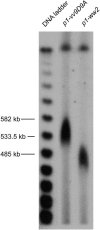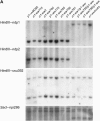A segmental deletion series generated by sister-chromatid transposition of Ac transposable elements in maize
- PMID: 15965263
- PMCID: PMC1456524
- DOI: 10.1534/genetics.104.035576
A segmental deletion series generated by sister-chromatid transposition of Ac transposable elements in maize
Abstract
Certain configurations of maize Ac/Ds transposon termini can undergo alternative transposition reactions leading to chromosome breakage and various types of stable chromosome rearrangements. Here, we show that a particular allele of the maize p1 gene containing an intact Ac element and a nearby terminally deleted Ac element (fAc) can undergo sister-chromatid transposition (SCT) reactions that generate large flanking deletions. Among 35 deletions characterized, all begin at the Ac termini in the p1 gene and extend to various flanking sites proximal to p1. The deletions range in size from the smallest of 12,567 bp to the largest of >4.6 cM; >80% of the deletions removed the p2 gene, a paralog of p1 located approximately 60 kb from p1 in the p1-vv allele and its derivatives. Sequencing of representative cases shows that the deletions have precise junctions between the transposon termini and the flanking genomic sequences. These results show that SCT events can efficiently generate interstitial deletions that are useful for in vivo dissection of local genome regions and for the rapid correlation of genetic and physical maps. Finally, we discuss evidence suggesting that deletions induced by alternative transposition reactions can occur at other genomic loci, indicating that this mechanism may have had a significant impact on genome evolution.
Figures







Similar articles
-
A transgenic system for generation of transposon Ac/Ds-induced chromosome rearrangements in rice.Theor Appl Genet. 2012 Nov;125(7):1449-62. doi: 10.1007/s00122-012-1925-4. Epub 2012 Jul 14. Theor Appl Genet. 2012. PMID: 22798058 Free PMC article.
-
Genome rearrangements in maize induced by alternative transposition of reversed ac/ds termini.Genetics. 2011 May;188(1):59-67. doi: 10.1534/genetics.111.126847. Epub 2011 Feb 21. Genetics. 2011. PMID: 21339479 Free PMC article.
-
Spatial configuration of transposable element Ac termini affects their ability to induce chromosomal breakage in maize.Plant Cell. 2010 Mar;22(3):744-54. doi: 10.1105/tpc.109.070052. Epub 2010 Mar 12. Plant Cell. 2010. PMID: 20228246 Free PMC article.
-
McClintock's controlling elements: the full story.Cytogenet Genome Res. 2005;109(1-3):90-103. doi: 10.1159/000082387. Cytogenet Genome Res. 2005. PMID: 15753564 Review.
-
How maize transposable elements escape negative selection.Trends Genet. 1990 May;6(5):155-8. doi: 10.1016/0168-9525(90)90150-5. Trends Genet. 1990. PMID: 2164267 Review.
Cited by
-
A transgenic system for generation of transposon Ac/Ds-induced chromosome rearrangements in rice.Theor Appl Genet. 2012 Nov;125(7):1449-62. doi: 10.1007/s00122-012-1925-4. Epub 2012 Jul 14. Theor Appl Genet. 2012. PMID: 22798058 Free PMC article.
-
Remobilization of Sleeping Beauty transposons in the germline of Xenopus tropicalis.Mob DNA. 2011 Nov 24;2:15. doi: 10.1186/1759-8753-2-15. Mob DNA. 2011. PMID: 22115366 Free PMC article.
-
Complex chromosomal rearrangements induced by transposons in maize.Genetics. 2023 Feb 9;223(2):iyac124. doi: 10.1093/genetics/iyac124. Genetics. 2023. PMID: 36111993 Free PMC article.
-
Ac/Ds-induced chromosomal rearrangements in rice genomes.Mob Genet Elements. 2012 Mar 1;2(2):67-71. doi: 10.4161/mge.20264. Mob Genet Elements. 2012. PMID: 22934239 Free PMC article.
-
Macrotransposition and other complex chromosomal restructuring in maize by closely linked transposons in direct orientation.Plant Cell. 2008 Aug;20(8):2019-32. doi: 10.1105/tpc.108.060582. Epub 2008 Aug 15. Plant Cell. 2008. PMID: 18708475 Free PMC article.
References
-
- Anderson, P. A., P. A. Okubara, R. Arroyo-Garcia, B. C. Meyers and R. W. Michelmore, 1996. Molecular analysis of irradiation-induced and spontaneous deletion mutants at a disease resistance locus in Lactuca sativa. Mol. Gen. Genet. 251: 316–325. - PubMed
-
- Bayley, C. C., M. Morgan, E. C. Dale and D. W. Ow, 1992. Exchange of gene activity in transgenic plants catalyzed by the Cre-lox site-specific recombination system. Plant Mol. Biol. 18: 353–361. - PubMed
Publication types
MeSH terms
Substances
LinkOut - more resources
Full Text Sources

